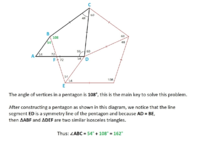If you really have a solution why don't you help me with a hint?Yes, I have a solution. However, on this forum we prefer for the student to figure out the solution with our help. Can you please post the most update diagram and any work that you did.
You are using an out of date browser. It may not display this or other websites correctly.
You should upgrade or use an alternative browser.
You should upgrade or use an alternative browser.
This one made me mad
- Thread starter Farzin
- Start date
firemath
Full Member
- Joined
- Oct 29, 2019
- Messages
- 602
Oh dear. I know a quarrel when I see one.If you really have a solution why don't you help me with a hint?
Please do NOT press Jomo to give you a solution...did you read the forum rules? We are here to help, not to give you answers.
The idea here is that Jomo will help you so you can do this by yourself.
Oh dear, I guess you didn't read all my posts here and you just jumped to a conclusion! Where did I ask for a solution? If you care to read my posts you will see that I was asking for help and a hint not a solution!!, help and hints were something that Jomo claimed he has. After all isn't this forum about helping and giving hints to those who need it? If Jomo doesn't want to help me then why he claimed that he has the solution? (which I don't think he has). By the way I was expecting Jomo to answer me not his lawyer!Oh dear. I know a quarrel when I see one.
Please do NOT press Jomo to give you a solution...did you read the forum rules? We are here to help, not to give you answers.
The idea here is that Jomo will help you so you can do this by yourself.
Steven G
Elite Member
- Joined
- Dec 30, 2014
- Messages
- 14,559
Actually I do not plan on having a quarrel. The OP time after time refused (until the last post) to supply us with a diagram so I planned on not helping anymore. As I stated, all I wanted to know, via a diagram, was where s/he was with the problem and a diagram would have helped.Oh dear. I know a quarrel when I see one.
Please do NOT press Jomo to give you a solution...did you read the forum rules? We are here to help, not to give you answers.
The idea here is that Jomo will help you so you can do this by yourself.
After I provided you with some of my diagrams, now you know that where I am with the problem, and now what? And also why do you think it is a quarrel? You are an Elite member in this forum and new comer like me expect you to be honest and act more patiently with us. It would definitely be fine if you could just tell me that you didn't have the solution and can't give me any hint and help so I can go and waste my time somewhere else Sir!Actually I do not plan on having a quarrel. The OP time after time refused (until the last post) to supply us with a diagram so I planned on not helping anymore. As I stated, all I wanted to know, via a diagram, was where s/he was with the problem and a diagram would have helped.
firemath
Full Member
- Joined
- Oct 29, 2019
- Messages
- 602
My point, @Farzin, is not that you are specifically asking for an answer. You have kindly been given hints by @Jomo and others--so I don't know why you are asking for "his hint" even though he has given you some very useful ones. I, for one, do not have anything against you. Just accept correction!Oh dear, I guess you didn't read all my posts here and you just jumped to a conclusion! Where did I ask for a solution? If you care to read my posts you will see that I was asking for help and a hint not a solution!!, help and hints were something that Jomo claimed he has. After all isn't this forum about helping and giving hints to those who need it? If Jomo doesn't want to help me then why he claimed that he has the solution? (which I don't think he has). By the way I was expecting Jomo to answer me not his lawyer!
On the note of your problem:
There is plenty of room, and as you asked for a geometric solution, I think that you should stop talking about angle chasing. Geometry contains much angle chasing.If your solution is a geometrical solution then it would be fantastic but if it is a trigonometry solution I should say that it is a very obvious solution and I already have it. I spent hours and drew many different diagrams on this problem just to find it's geometric solution, I'm sure there is not enough room to post all of the drawings here. In this forum I didn't ask for solution and I know people should figure out the solution by their own, as you can see I just asked for hints. If there is no problem I can post all my diagrams in here. If you really have a geometric solution then please tell me the first step and I hope I can do the rest by myself, but so far your hints were just about angle chasing which I already have done it many many times before. Thanks!
Ok you changed your mind now because you were telling me that I shouldn't press Jomo to give a solution and now you say your point is not that, right? And also if you read the posts carefully you will realize that Jomo himself admitted that he were only giving me angle chasing hints, nothing else. (which were not helping to solve the problem at all). And also I am very much disappointed with this issue that why is it necessary to come with useless hints and suggestions and at the same time pretending to have a solution to a problem but denying to give any help, to me it is just a show of.My point, @Farzin, is not that you are specifically asking for an answer. You have kindly been given hints by @Jomo and others--so I don't know why you are asking for "his hint" even though he has given you some very useful ones. I, for one, do not have anything against you. Just accept correction!
On the note of your problem:
There is plenty of room, and as you asked for a geometric solution, I think that you should stop talking about angle chasing. Geometry contains much angle chasing.
Steven G
Elite Member
- Joined
- Dec 30, 2014
- Messages
- 14,559
The OP in fact has always asked for hints and not a complete solution.My point, @Farzin, is not that you are specifically asking for an answer. You have kindly been given hints by @Jomo and others--so I don't know why you are asking for "his hint" even though he has given you some very useful ones. I, for one, do not have anything against you. Just accept correction!
On the note of your problem:
There is plenty of room, and as you asked for a geometric solution, I think that you should stop talking about angle chasing. Geometry contains much angle chasing.
God bless you, now are you willing to give me a real hint and the first step to take in order to help me to solve the problem?The OP in fact has always asked for hints and not a complete solution.
I am sure you don't know much about geometry otherwise you shouldn't have called that a hint. Where did I ask him to prove that he has a solution? Do you really read the posts? That was him who said that he had the solution. You are right, you are confused, because you don't read the posts carefully.He asks for hints, and receives them...but then he asks you to prove that you have a solution....Why don't you believe Jomo, @Farzin? That's why I'm confused.
Dr.Peterson
Elite Member
- Joined
- Nov 12, 2017
- Messages
- 16,604
Let's stop arguing and get back to the problem! Things got off track because of a delay in communication; I just want to see an answer.
I haven't found a geometrical solution yet; I tend to expect that if there is one, it will depend on some ingenious perspective, and maybe none of us will see it. I did construct the figure in GeoGebra (as an alternative to carrying out the trig), and it appears that the answer is a nice whole number of degrees, which supports the supposition that there is a "simple" method.
Jomo, do you have such a solution for which you can provide a hint, or did you just mean that you knew the answer?
I haven't found a geometrical solution yet; I tend to expect that if there is one, it will depend on some ingenious perspective, and maybe none of us will see it. I did construct the figure in GeoGebra (as an alternative to carrying out the trig), and it appears that the answer is a nice whole number of degrees, which supports the supposition that there is a "simple" method.
Jomo, do you have such a solution for which you can provide a hint, or did you just mean that you knew the answer?
Dr.Peterson
Elite Member
- Joined
- Nov 12, 2017
- Messages
- 16,604
I'm wondering now if there could at least be a trig solution that could be worked out in such a way as to provide an exact answer; that might also provide a hint to a geometric solution.
But maybe it would also be helpful if @Farzin told us the source of the problem, which might at least give us an idea what level of thinking should be needed, and whether we should feel bad not having found a nice solution yet. That is requested in the Guidelines Summary.
But maybe it would also be helpful if @Farzin told us the source of the problem, which might at least give us an idea what level of thinking should be needed, and whether we should feel bad not having found a nice solution yet. That is requested in the Guidelines Summary.
I don't really know the source of the problem doc, it was just given to me. I am working on it in almost every spare time I have and if I find a geometrical solution I will definitely share it with you.I'm wondering now if there could at least be a trig solution that could be worked out in such a way as to provide an exact answer; that might also provide a hint to a geometric solution.
But maybe it would also be helpful if @Farzin told us the source of the problem, which might at least give us an idea what level of thinking should be needed, and whether we should feel bad not having found a nice solution yet. That is requested in the Guidelines Summary.
Dr.Peterson
Elite Member
- Joined
- Nov 12, 2017
- Messages
- 16,604
Well, that is a source. What kind of person gave it to you (a friend, an enemy, a teacher, a mathematician, ...)? And did they tell you there is a geometrical solution, or are you just imagining there must be (as I am as well, but without the "must")?
I'll point you to the problem this distantly reminds me of: https://thinkzone.wlonk.com/MathFun/Triangle.htm . I recall finding a page with several very different solutions, but can't find it just now. The difference, of course, is that your problem doesn't have such simple angles, though it does have some other useful relationships.
I'll point you to the problem this distantly reminds me of: https://thinkzone.wlonk.com/MathFun/Triangle.htm . I recall finding a page with several very different solutions, but can't find it just now. The difference, of course, is that your problem doesn't have such simple angles, though it does have some other useful relationships.
The person who gave me this problem is a teacher and we met each other in a math group in a social media site. We don't know if there is a geometrical solution to this problem. And about the problem in that link in your post, I have solved it before in 4 different ways and a general solution too.Well, that is a source. What kind of person gave it to you (a friend, an enemy, a teacher, a mathematician, ...)? And did they tell you there is a geometrical solution, or are you just imagining there must be (as I am as well, but without the "must")?
I'll point you to the problem this distantly reminds me of: https://thinkzone.wlonk.com/MathFun/Triangle.htm . I recall finding a page with several very different solutions, but can't find it just now. The difference, of course, is that your problem doesn't have such simple angles, though it does have some other useful relationships.
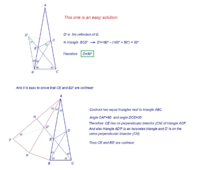
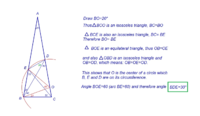
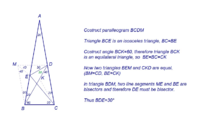
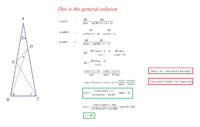
Thought I would wade in and have a go at a geometric solution to this problem.
Our aim is to determine ∠CDO and then use this angle to work out x given that
∠OAK = 48° and ∠DOA = 96°.
∠CDO + ∠DOA + ∠OAK + x = 360° (angle sum of quadrilateral OAKD)
Extend line from K to C to produce isosceles ΔDCO.
Draw lines from O to B, K to G and G to B to produce ΔAGB.
Note ∠AGB at the circumference is subtended by diameter AB and therefore equals 90° (circle theorem).
We know ∠OAG = 48°. It follows ∠GBA = 42° since angle sum of triangle = 180°.
Draw chord DB to produce isosceles ΔDOB.
∠DOB + ∠DOA = 180°
∠DOB + 96° = 180°
∠DOB = 84°
∠ODB = ∠DBO = 48° (OD and OB are both radii)
Draw chords BH and CH to complete the cyclic quadrilateral CDBH.
ΔCOH and ΔHOB are both isosceles triangles (each has two sides which are radii).
∠HOB = 96° (supplementary to ∠DOB = 84°)
∠OHB = 42° ∠OBH = 42°
Consider the angle at the circumference (∠GAB = 48°) which is subtended by the arc GB. The related circle theorem states that this angle is half the angle at the centre (∠GOB = 96°) subtended by the same arc.
∠DOG = ∠GOB - ∠DOB
= 96° - 84°
= 12°
Consider ∠GOA in ΔAGO.
We know ∠DOB + ∠DOG + ∠GOA = 180°
It follows 84° + 12° + ∠GOA = 180°
∠GOA = 84°
If we rotate ΔAGO 12° anticlockwise about centre O it will coincide with ΔLDO.
This means ∠LOA = 12°
Starting at L and moving clockwise around the circle until we reach G we have moved through three angles:
∠LOH = ∠LOA + ∠AOH (vertically opposite ∠DOB)
= 12° + 84°
= 96°
∠HOB = 96° (vertically opposite ∠DOA)
∠GOB = 96°
Total = 288°
An angle of 72° (∠GOL) completes the circle.
Consider ΔGOL. If we rotate it 12° anticlockwise about centre O it will coincide with ΔDOC.
It follows ∠COL = 12° (as we have just rotated through this angle)
and ∠DOC = 72° (superimposed by ∠GOL).
Consider isosceles ΔDOC.
∠DOC + ∠DCO + ∠CDO = 180° where ∠DCO = ∠CDO
72° + 2∠DCO = 180°
2∠DCO = 108°
∠DCO = 54° and ∠CDO = 54°
Consider quadrilateral OAKD.
∠CDO + ∠DOA + ∠OAK + x = 360°
54° + 96° + 48° + x = 360°
198° + x = 360°
x = 162°
Angle check:
Consider isosceles ΔDOC.
∠COH = 108° (supplementary to ∠DOC which is 72°)
Two equal angles: ∠OCH = 36° ∠CHO = 36°
Consider cyclic quadrilateral CGBH.
Circle theorem: opposite angles of a cyclic quadrilateral add up to 180°.
We know ∠OHB = 42° and ∠CHO = 36° therefore ∠CHB = 78°
It follows ∠CGB = 102°
Consider ΔAGB.
We know ∠GAO = 48° ∠GBO = 42° and∠AGB is a right angle.
It follows ∠CGA = 12° (angle at circumference subtended by the arc CA).
From the above circle theorem the angle at the centre (∠COA) subtended by the arc CA is 24°.
∠DOC + ∠COA = ∠DOA
72° + 24° = 96° which is correct from the diagram
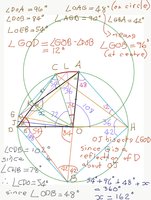
Our aim is to determine ∠CDO and then use this angle to work out x given that
∠OAK = 48° and ∠DOA = 96°.
∠CDO + ∠DOA + ∠OAK + x = 360° (angle sum of quadrilateral OAKD)
Extend line from K to C to produce isosceles ΔDCO.
Draw lines from O to B, K to G and G to B to produce ΔAGB.
Note ∠AGB at the circumference is subtended by diameter AB and therefore equals 90° (circle theorem).
We know ∠OAG = 48°. It follows ∠GBA = 42° since angle sum of triangle = 180°.
Draw chord DB to produce isosceles ΔDOB.
∠DOB + ∠DOA = 180°
∠DOB + 96° = 180°
∠DOB = 84°
∠ODB = ∠DBO = 48° (OD and OB are both radii)
Draw chords BH and CH to complete the cyclic quadrilateral CDBH.
ΔCOH and ΔHOB are both isosceles triangles (each has two sides which are radii).
∠HOB = 96° (supplementary to ∠DOB = 84°)
∠OHB = 42° ∠OBH = 42°
Consider the angle at the circumference (∠GAB = 48°) which is subtended by the arc GB. The related circle theorem states that this angle is half the angle at the centre (∠GOB = 96°) subtended by the same arc.
∠DOG = ∠GOB - ∠DOB
= 96° - 84°
= 12°
Consider ∠GOA in ΔAGO.
We know ∠DOB + ∠DOG + ∠GOA = 180°
It follows 84° + 12° + ∠GOA = 180°
∠GOA = 84°
If we rotate ΔAGO 12° anticlockwise about centre O it will coincide with ΔLDO.
This means ∠LOA = 12°
Starting at L and moving clockwise around the circle until we reach G we have moved through three angles:
∠LOH = ∠LOA + ∠AOH (vertically opposite ∠DOB)
= 12° + 84°
= 96°
∠HOB = 96° (vertically opposite ∠DOA)
∠GOB = 96°
Total = 288°
An angle of 72° (∠GOL) completes the circle.
Consider ΔGOL. If we rotate it 12° anticlockwise about centre O it will coincide with ΔDOC.
It follows ∠COL = 12° (as we have just rotated through this angle)
and ∠DOC = 72° (superimposed by ∠GOL).
Consider isosceles ΔDOC.
∠DOC + ∠DCO + ∠CDO = 180° where ∠DCO = ∠CDO
72° + 2∠DCO = 180°
2∠DCO = 108°
∠DCO = 54° and ∠CDO = 54°
Consider quadrilateral OAKD.
∠CDO + ∠DOA + ∠OAK + x = 360°
54° + 96° + 48° + x = 360°
198° + x = 360°
x = 162°
Angle check:
Consider isosceles ΔDOC.
∠COH = 108° (supplementary to ∠DOC which is 72°)
Two equal angles: ∠OCH = 36° ∠CHO = 36°
Consider cyclic quadrilateral CGBH.
Circle theorem: opposite angles of a cyclic quadrilateral add up to 180°.
We know ∠OHB = 42° and ∠CHO = 36° therefore ∠CHB = 78°
It follows ∠CGB = 102°
Consider ΔAGB.
We know ∠GAO = 48° ∠GBO = 42° and∠AGB is a right angle.
It follows ∠CGA = 12° (angle at circumference subtended by the arc CA).
From the above circle theorem the angle at the centre (∠COA) subtended by the arc CA is 24°.
∠DOC + ∠COA = ∠DOA
72° + 24° = 96° which is correct from the diagram


